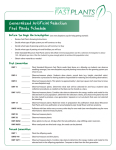Generalized Artificial Selection Fast Plants Schedule
View This Resource
This fill-in-the-blank timeline is a planning tool for teachers to use when figuring out when to begin the steps associated with conducting a two-generation artificial selection experiment using Fast Plants. Teachers preparing for any selection experiment will find this timeline helpful, including those planning for the AP Biology Lab 1 of Big Idea 1: Evolution, Artificial Selection.
Alternate Title
Artificial Selection Timeline
Subject
Species
Phenotypic Trait
Media Format
Materials Development Era
Resource Type
Language
Typical Learning Time
52-58 days
Audience
Education Level
Creator
Contributor
Publisher
Source
The Wisconsin Fast Plants Program
Rights
This work by Wisconsin Fast Plants Program is licensed under Attribution-NonCommercial-ShareAlike 4.0 International
Date Issued
March 15th, 2012
Email Address
info@fastplants.org
Classification
- Educational Resources
- Educational Resources -- Grade Level: Secondary
- Educational Resources -- How to grow Fast Plants
- Educational Resources -- Grade Level: Undergraduate
- Educational Resources -- Grade Level: Middle School -- Current Middle Level Resources
- Educational Resources -- Grade Level: Secondary -- Current Secondary Resources
- Educational Resources -- Grade Level: Secondary -- AP Biology Resource
NGSS Standard
- NGSS.HS.LS3.3 Apply concepts of statistics and probability to explain the variation and distribution of expressed traits in a population. [Clarification Statement: Emphasis is on the use of mathematics to describe the probability of traits as it relates to genetic and environmental factors in the expression of traits.] [Assessment Boundary: Assessment does not include Hardy-Weinberg calculations.]
- NGSS.HS.LS4.4 Construct an explanation based on evidence for how natural selection leads to adaptation of populations. [Clarification Statement: Emphasis is on using data to provide evidence for how specific biotic and abiotic differences in ecosystems (such as ranges of seasonal temperature, long-term climate change, acidity, light, geographic barriers, or evolution of other organisms) contribute to a change in gene frequency over time, leading to adaptation of populations.]
- NGSS.MS.LS4.4 Construct an explanation based on evidence that describes how genetic variations of traits in a population increase some individuals’ probability of surviving and reproducing in a specific environment. [Clarification Statement: Emphasis is on using simple probability statements and proportional reasoning to construct explanations.]
- NGSS.MS.LS4.6 Use mathematical representations to support explanations of how natural selection may lead to increases and decreases of specific traits in populations over time. [Clarification Statement: Emphasis is on using mathematical models, probability statements, and proportional reasoning to support explanations of trends in changes to populations over time.] [Assessment Boundary: Assessment does not include Hardy Weinberg calculations.]

Comments